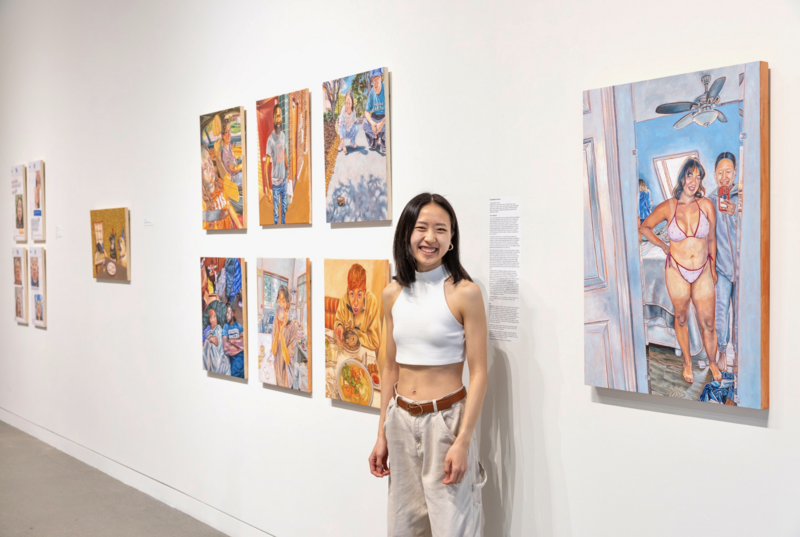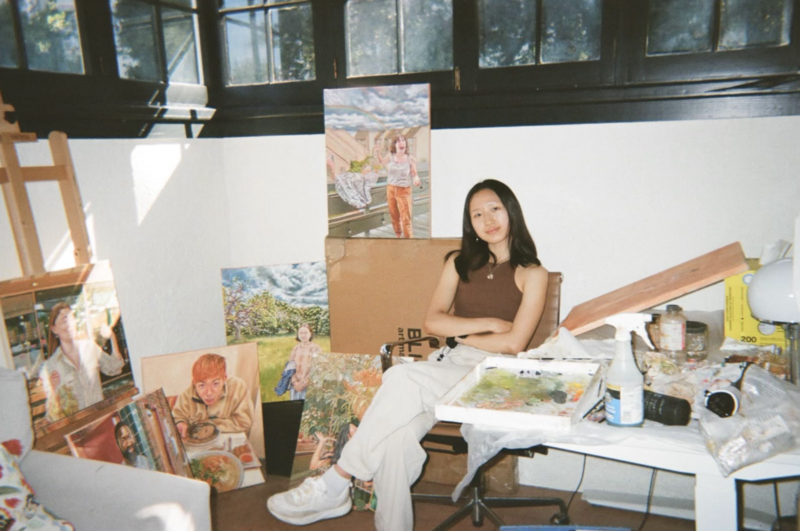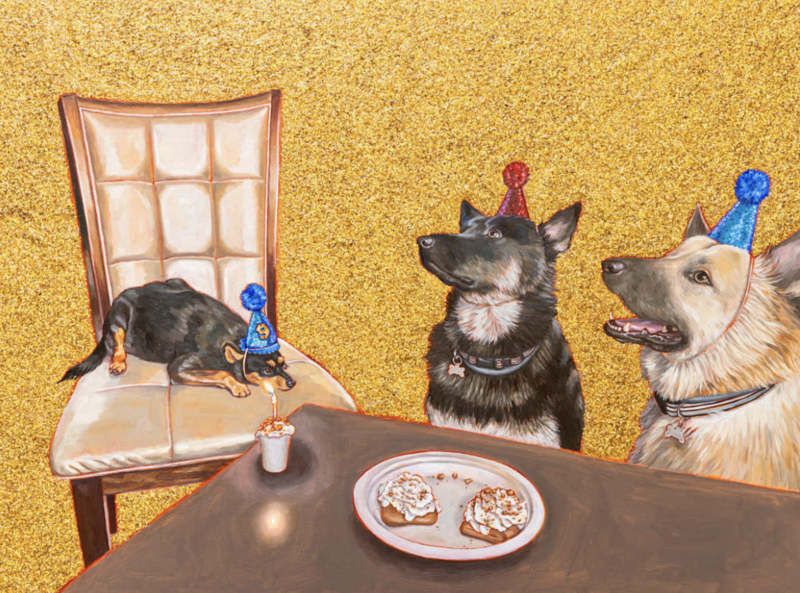"For years, my compositions were dominated by dark color palettes, screaming faces, tendrilled monstrosities. Harnessing this hurt was cathartic, but reviving ghosts of the past inevitably took an emotional toll."
That's when Featured Artist Jackie Liu tried something different—joy. With oil paint layered over vibrant acrylic underpaintings, Jackie Liu's art not only captures moments of joy, but, as the artist puts it, moments that "feel viscerally joyful to create."
Liu is a disabled Chinese American painter and storyteller based in California, living with a range of physical and mental illnesses. Her work is informed—but not defined—by the trauma threaded through those experiences. Her paintings explore joy, wonder, playfulness, and humor as "modes of resistance”—ways to survive and imagine something better.
Rendered with meticulous care, her portraits highlight the radiant moments often lost in daily life. Through painting, she reclaims presence of those moments slowly, deliberately, and with deep reverence.
Artwork Archive had the chance to chat with Jackie Liu about her creative process, how she protects the joy at the heart of her practice, and why Artwork Archive has become such an important tool in her art career.
You can see more of her work on Discovery and learn more about her art practice below:
Jackie Liu, Big Day for Small Dog, 18 x 24 x 0.75 in, 2025
What Glows Beneath the Surface
Inside Jackie Liu’s studio, the her creative process often begins on her phone. Her camera roll has become an archive. It’s where she mines for "moments of snorting laughter or tranquil ease; moments of togetherness and enoughness; moments when my chest felt tight from my heart straining to burst against it."
From there, the process becomes tactile. She paints on wood panels for their stability and smoothness. After layering gesso, she covers the surface in a wash of burnt sienna acrylic. Then comes the underpainting—every line mapped out carefully, pulled directly from the photo that sparked the idea. “This part feels more like drawing than painting,” Liu notes. “Drawing was my first love.”
Once that layer dries, the oils come out. Working in sweeping layers, she paints alla prima, completing small sections before moving on. "I find that this method satisfies my OCD brain's need for closure and my ADHD brain's need for instant gratification," she explains, "dolling out little victories when I finish rendering a small piece of the larger puzzle."
She lets the warm orange of the underpainting peek through on purpose. It blinks through the surface, glowing just enough to give the final work a sense of life beneath it. “Retaining visibility of the first layer embeds the history of the piece’s creation within the final product,” the artist says. “A geological record of pigment.”
Eventually, there comes a point when she has to stop. “I find myself obsessing over details that might bother me deeply, but that no one else would ever notice,” Liu admits. That’s when, battling her perfectionism, she forces herself to put the brush down, and accept that the piece is good enough.
Painting Joy While Carrying Grief
Jackie Liu paints joy in a way that feels defiant—a refusal to let hardship eclipse everything else. Her creative process is entangled with her experience of chronic illness, mental health challenges, and the loud echoes of trauma.
“My struggles with physical and mental illness have greatly informed my practice,” she writes with stark honesty. “On top of living with ADHD, anxiety, bipolar, depression, eating disorders, OCD, OCPD, and panic disorder, I have grappled with Long Covid for over two years, which manifests in unpredictable waves of extreme fatigue, migraines, nausea, and brain fog.”
But joy still finds a place. And Liu insists on making room for it. "I choose to respond to this trauma with a ferocious and irreverent joy," she emphasizes. “Insisting upon the seriousness of joy is an act of liberation in itself, an assertion of full humanity and the right to flourish.”
She credits the brightness in her paintings as a deliberate path through her pain. "Joy is what emerges from having lost and having something to lose. Joy is what empowers us to resist the injustices of the present and open our imaginations to new possibilities. Joy is what galvanizes us to fight and go on. Joy is what binds us together.”
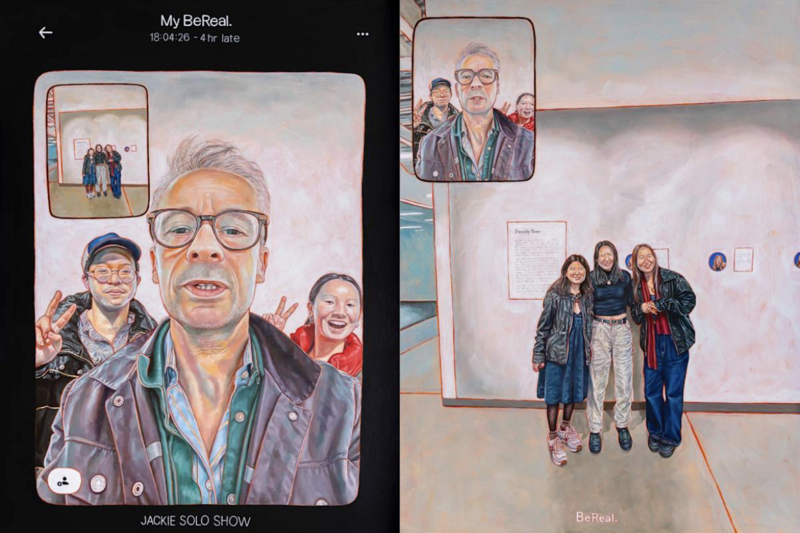
Jackie Liu, Professor Nemerov Takes Over Audrey's BeReal, 24" x 18" x 1.5", 2025
Why the Small Things Matter
In Liu’s work, everyday objects carry the same weight as extraordinary ones would. A shoe, a slouch in a T-shirt, the way wood grain catches the light—these are things she paints with admiration. For her, painting is an act of noticing.
"I see painting as a practice of intimacy and attunement,” she deems. “A willingness to see the world in a new way, a desire to seek poetry in the prosaic.”
She believes anything can be worth remembering—it’s about what you choose to look at, and how long you’re willing to look. “To expand the terrain of attention is to expand what we consider deserving of care,” Liu adds thoughtfully. Through painting, she lingers on moments that might otherwise go unseen, "unveiling their shimmering dynamism and everyday magic."
What She Would Say to Her Younger Self
In 2020, as a high school senior quarantining in her basement, Jackie Liu began posting her paintings online—sharing deeply personal stories about control, trauma, and identity. "I spoke aloud the scary things, the shameful things, the painful things that most clutch deeply within," she remembers.
And the internet responded. Her videos went viral, her follower count grew, and strangers across continents bought her work. Students interviewed her. People tattooed her work on their bodies.
"It was a blessing. It was surreal. It was too much."
Eventually, even opening a sketchbook came with dread, and guilt slithered into her process. “Was I commodifying my own trauma? Turning suffering into spectacle?” the artist wondered. The weight of constantly translating her pain into captions, views, and engagement became unbearable. “Trauma doesn’t translate well into performance analytics.”
Back then, sharing everything felt like a survival strategy—a way to prove the worst was behind her. “I overshared as a means of coping, shining a flashlight under my bed to prove there was no monster lurking,” she admits, looking back. “But my wounds remained raw and bleeding. I should have let them scab over and flake off in scaly chunks, but I didn’t know how. So I exposed myself to fire, hoping that cauterization would expedite the healing process.”
Now, with some distance, perspective, and compassion, she knows exactly what she’d whisper to that version of herself:
“I would give that scared girl a long and tight hug. I would tell her that it’s okay to protect her privacy, that working through her grief in such a public forum might turn out to be traumatizing in itself,” Liu offers. “I would tell her that pain isn’t the only source of creativity she has to draw upon—she has so much more inside her. I would tell her to leave the darkness in her wake, and instead reach toward the shimmering beautiful things.”
When Algorithms Hijacked Her Creative Process
There was a time when our Featured Artist's relationship with art started to unravel. As her audience grew, so did the pressure—to share more, perform more, and to make work that fed the feed.
She points to Sophie Bishop’s concept of “influencer creep”—a term describing how artists are increasingly expected to build public personas alongside their creative practices. Liu saw herself in that definition. Painting became entangled with self-marketing and algorithm-friendly content.
“I have personally suffered the consequences of this ‘influencer creep’ phenomenon,” she shares, “and it almost destroyed my relationship with art.”
The bigger her social media presence grew, the more disconnected she felt. “I felt increasing pressure to create what I thought others wanted to see, rather than what I intrinsically wanted to make.” The joy she once found in the process faded into burnout, and things became hollow.
Letting go of that pressure changed everything. “I stopped caring so much about metrics and virality,” Liu explains. “I also grew less concerned about making things that might be deemed ‘intellectually sophisticated’ or ‘good’ according to external art world standards, and now instead try to determine what feels good to me.”
It’s so easy to yield to the overwhelming pressures of markets, algorithms, and trends, especially when it feels like your financial stability and career trajectory are on the line. But her reminder to other artists: protect your intuition; protect your time. “In order to maintain a sustainable, lifelong practice, you have to prioritize the art above all else.”
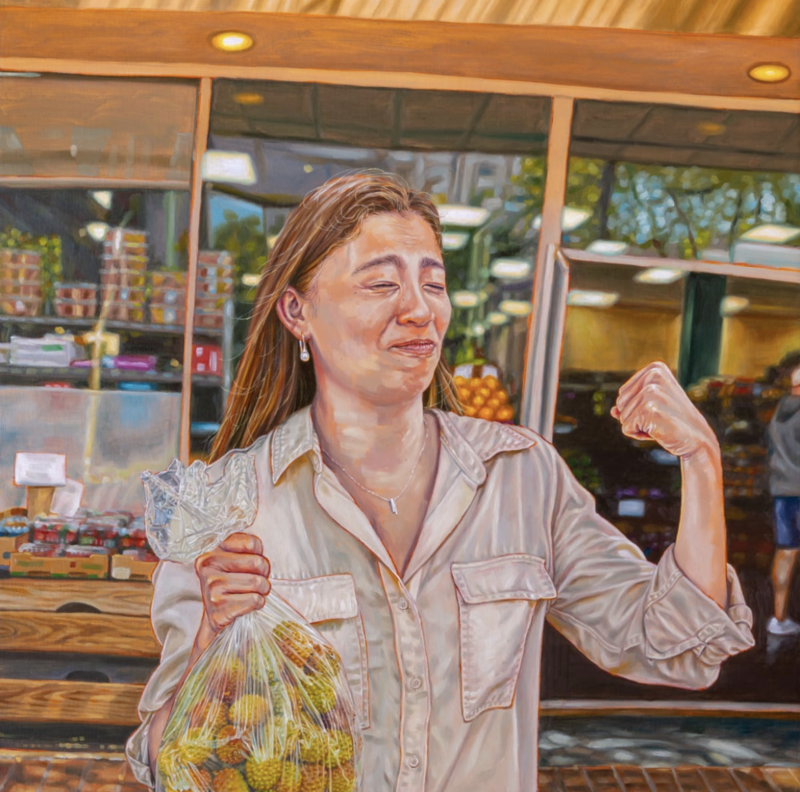
Jackie Liu, Lychee Haul,18 x 18 x 0.875 in, 2024
What Helps Her Stay Focused—and In the Studio
Jackie Liu discovered Artwork Archive through a link buried in the alumni newsletter from Artists for Humanity, a Boston-based nonprofit she had spent summers with during high school. “They posted a link to sign up for one of Artwork Archive’s ‘Getting Started’ webinars, which caught my eye,” she remembers.
She clicked. She watched. And she signed up the same day.
“The webinar truly blew my mind,” Liu recounts. “I had never encountered something that could address so many of my needs as an artist within a single consolidated platform. As soon as I exited the Zoom, I immediately signed up for an account.”
Before that, her "system" was a patchwork of half-solutions and digital chaos. A spreadsheet for inventory. A janky Word template for invoicing. A high school-era Google Site that had long outlived its usefulness. “I relied on a disjointed hodgepodge of spreadsheets, documents, and accounting softwares to keep track of my pieces, exhibitions, applications, sales, and expenses,” she recalls. Every time she had to track something down, it took longer than it should have. And it chipped away at her energy.
Consolidating all of that into one system was a timesaver—and a mental reset. Artwork Archive gave her back headspace, clarity, and room to prioritize what actually mattered. “With all these previously-scattered components now seamlessly integrated,” Liu explains, “I feel far more confident in my professionalism as an artist, and thereby in the viability of my long-term career.”
Clarity Changes How You Work
Most artists don’t start out with a clean system—and that’s okay. But working from scattered folders and clunky spreadsheets can chip away at your time AND creative energy.
That’s where our Getting Started webinar comes in. Held twice a month, this live session walks you through practical ways to build a studio system that keeps your inventory, sales, and contacts in one place—so you can stay organized, look professional, and stay focused on making the work.
→ Reserve your spot for the next one
Her Favorite (Metaphorical) Children
There’s no shortage of tools Jackie Lui finds useful inside her Artwork Archive account. “Choosing a favorite Artwork Archive feature is like choosing a favorite child,” she quips. “I have many favorite metaphorical children!”
Still, a few have earned their spot at the top: piece records, Income & Expense tracking, and the ability to log where each artwork has been exhibited. Those tools alone have helped her stay grounded in the logistical side of her career. But there’s one under-the-radar feature she’s found unexpectedly essential: the description field.
Tucked into every Piece Record, it’s where she now stores the most current descriptions of her work—descriptions that once lived across a mess of folders, old applications, and buried email threads—with the artist often unsure which version was the most recent or most accurate. “Now, I can turn to Artwork Archive as the single source of all the most up-to-date descriptions of my pieces,” she states.
On top of that, the private notes section of each Piece Record is used to store multiple versions of each description, depending on what she needs—longer, more reflective text for a proposal, or something shorter and punchier for a wall label. Those private notes have also become a place for personal record-keeping—like tracking how many hours she spent completing a painting. It’s not something the outside world sees, but it gives her a clearer understanding of her own time and effort, a form of validation in a profession where so much goes unseen.
"These features feel small," the painter observes, "but they add up to something big." Together, they've built the invisible structure that gives her what every artist deserves more of: time and space to be more present with the art itself.
Find the Tools That Fit Your Practice:
Jackie Liu swears by her Piece Records (with description fields) and Income & Expense tracking—but every artist finds their own “must-haves” inside Artwork Archive. Some rely on Inventory Reports to prep for exhibitions. Others use Private Rooms to create a more curated experience for collectors. Invoices are another favorite, especially during busy sales seasons.
→ Browse the full feature list here—your new go-to might be waiting.
